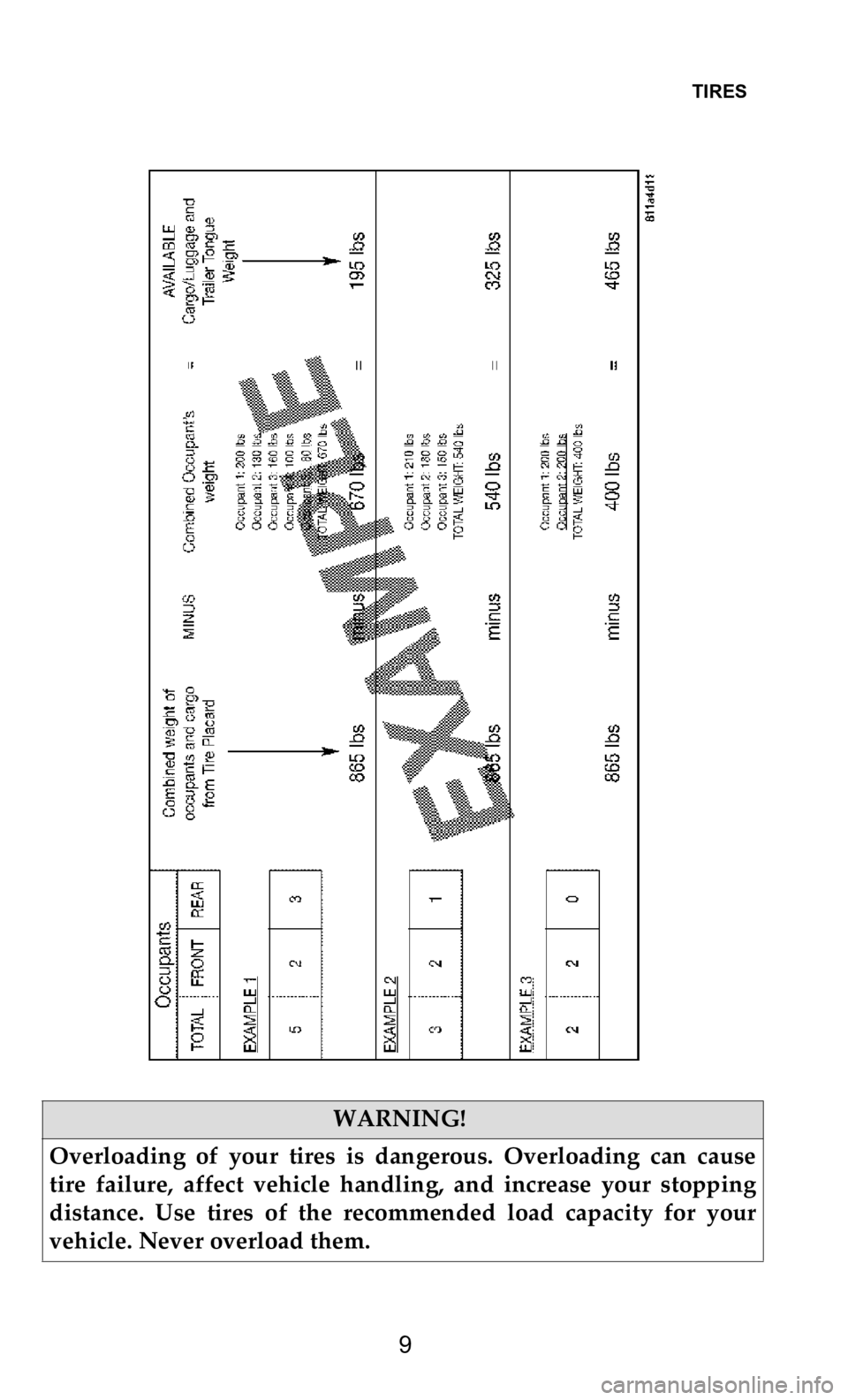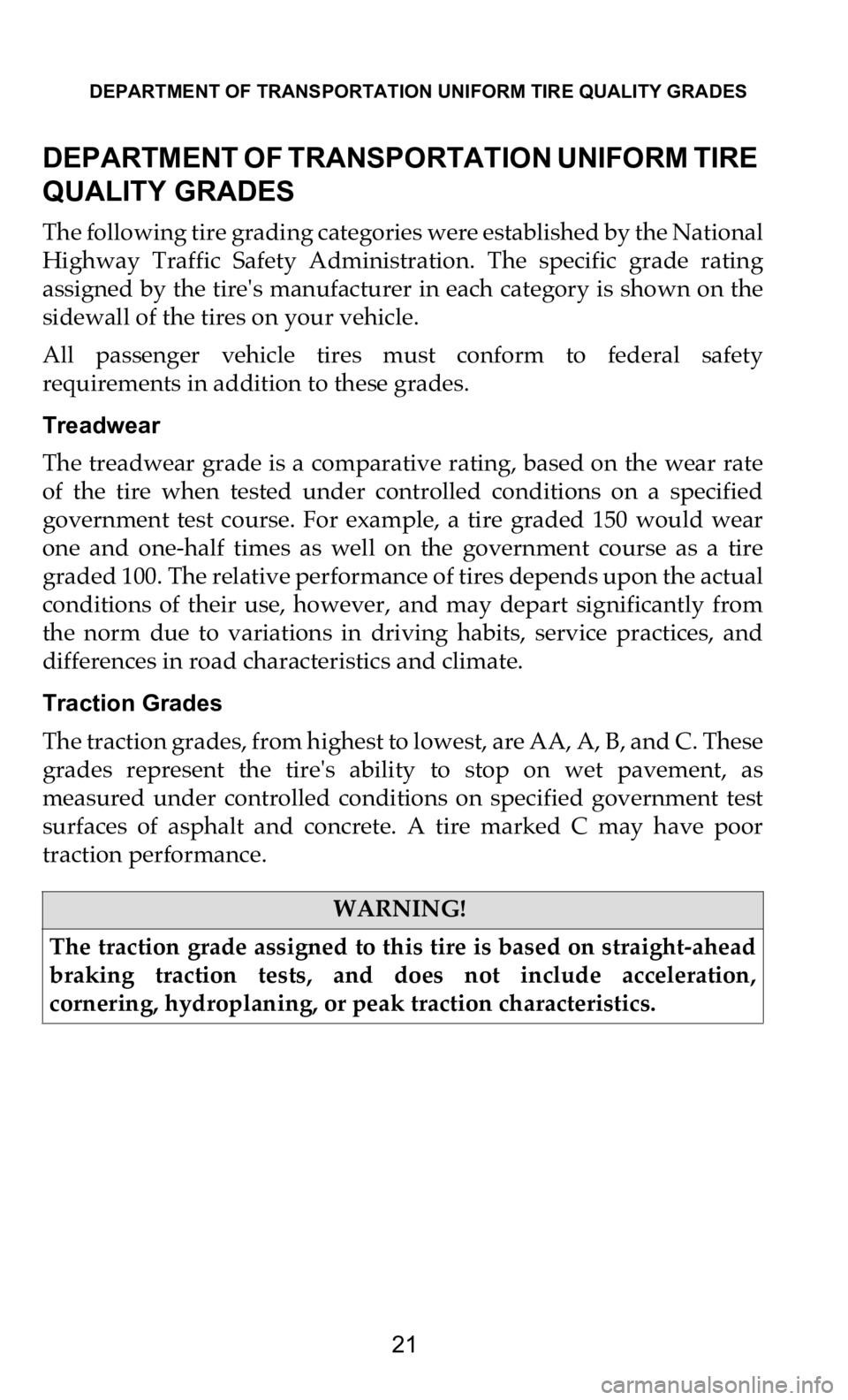warning DODGE DURANGO 2021 Vehicle Warranty
[x] Cancel search | Manufacturer: DODGE, Model Year: 2021, Model line: DURANGO, Model: DODGE DURANGO 2021Pages: 262, PDF Size: 10.42 MB
Page 10 of 262

TIRES
9
WARNING!
Overloading of your tires is dangerous. Overloading can cause
ti
re failure, affect vehicle handling, and increase your stopping
distance. Use tires of the recommended load capacity for your
vehicle. Never overload them.
Page 11 of 262

TIRES
10
Tires — General Information
Tire Pressure
Proper tire inflation pressure is essential to the safe and satisfactory
op
eration of your vehicle. Four primary areas are affected by
improper tire pressure:
• Safety and Vehicle Stability
•
Economy
•
Tread Wear
•
Ride Comfort
S
afety
Both underinflation and overinflation affect the stability of the vehicle
a n
d can produce a feeling of sluggish response or over responsiveness
in the steering.
NOTE:
• Unequal tire pressures from side to side may cause erratic and
unpredictable steering response.
• Unequal tire pressure from side to side may cause the vehicle to drift
l
eft or right.
WARNING!
• Improperly inflated tires are dangerous and can cause collisions.
•
Underinflation increases tire flexing and can result in over -
h
eating and tire failure.
• Overinflation reduces a tire's ability to cushion shock. Objects
o
n the road and chuckholes can cause damage that result in tire
failure.
• Overinflated or underinflated tires can affect vehicle handling
a
nd can fail suddenly, resulting in loss of vehicle control.
• Unequal tire pressures can cause steering problems. You could
l
ose control of your vehicle.
• Unequal tire pressures from one side of the vehicle to the other
c
an cause the vehicle to drift to the right or left.
• Always drive with each tire inflated to the recommended cold
t
ire inflation pressure.
Page 13 of 262

TIRES
12
Example: If garage temperature = 68°F (20°C) and the outside
temperature = 32°F (0°C) then the cold tire inflation pressure should
be increased by 3 psi (21 kPa), which equals 1 psi (7 kPa) for every 12°F
(7°C) for this outside temperature condition.
Tire pressure may increase from 2 to 6 psi (13 to 40 kPa) during
op
eration. DO NOT reduce this normal pressure build up or your tire
pressure will be too low.
Tire Pressures For High Speed Operation
FCA US LLC advocates driving at safe speeds and within posted
sp
eed limits. Where speed limits or conditions are such that the
vehicle can be driven at high speeds, maintaining correct tire inflation
pressure is very important. Increased tire pressure and reduced
vehicle loading may be required for high-speed vehicle operation.
Refer to an authorized tire dealer or original equipment vehicle dealer
for recommended safe operating speeds, loading and cold tire
inflation pressures.
Radial Ply Tires
WARNING!
High speed driving with your vehicle under maximum load is
da
ngerous. The added strain on your tires could cause them to
fail. You could have a serious collision. Do not drive a vehicle
loaded to the maximum capacity at continuous speeds above
75 mph (120 km/h).
WARNING!
Combining radial ply tires with other types of tires on your
ve
hicle will cause your vehicle to handle poorly. The instability
could cause a collision. Always use radial ply tires in sets of four.
Never combine them with other types of tires.
Page 15 of 262

TIRES
14
Tread Wear Indicators
Tread wear indicators are in the original equipment tires to help you
in
determining when your tires should be replaced.
Tire Tread
These indicators are molded into the bottom of the tread grooves.
They will appear as bands when the tread depth becomes a 2/32 of an
inch (1.6 mm). When the tread is worn to the tread wear indicators, the
ti
re should be replaced.
Refer to “Replacement Tires” in this section for further information.
WARNING!
Fast spinning tires can be dangerous. Forces generated by
ex
cessive wheel speeds may cause tire damage or failure. A tire
could explode and injure someone. Do not spin your vehicle's
wheels faster than 30 mph (48 km/h) for more than 30 seconds
co
ntinuously when you are stuck, and do not let anyone near a
spinning wheel, no matter what the speed.
1 — Worn Tire
2 — New Tire
Page 16 of 262

TIRES
15
Life Of Tire
The service life of a tire is dependent upon varying factors including,
bu
t not limited to:
• Driving style.
•
Tire pressure - Improper cold tire inflation pressures can cause
u
neven wear patterns to develop across the tire tread. These
abnormal wear patterns will reduce tread life, resulting in the need
for earlier tire replacement.
• Distance driven.
•
Performance tires, tires with a speed rating of V or higher, and
S
ummer tires typically have a reduced tread life. Rotation of these
tires per the vehicle scheduled maintenance is highly recom -
mended.
Keep dismounted tires in a cool, dry place with as little exposure to
l i
ght as possible. Protect tires from contact with oil, grease, and
gasoline.
Replacement Tires
The tires on your new vehicle provide a balance of many
ch
aracteristics. They should be inspected regularly for wear and
correct cold tire inflation pressures. FCA US LLC strongly
recommends that you use tires equivalent to the originals in size,
quality and performance when replacement is needed. Refer to the
paragraph on “Tread Wear Indicators” in this section. Refer to the Tire
and Loading Information placard or the Vehicle Certification Label for
the size designation of your tire. The Load Index and Speed Symbol
for your tire will be found on the original equipment tire sidewall.
See the Tire Sizing Chart example found in the “Tire Safety
In
formation” section of this manual for more information relating to
the Load Index and Speed Symbol of a tire.
WARNING!
Tires and the spare tire should be replaced after six years,
re
gardless of the remaining tread. Failure to follow this warning
can result in sudden tire failure. You could lose control and have a
collision resulting in serious injury or death.
Page 17 of 262

TIRES
16
It is recommended to replace the two front tires or two rear tires as a
pair. Replacing just one tire can seriously affect your vehicle’s
handling. If you ever replace a wheel, make sure that the wheel’s
specifications match those of the original wheels.
It is recommended you contact an authorized tire dealer or original
eq
uipment dealer with any questions you may have on tire
specifications or capability. Failure to use equivalent replacement tires
may adversely affect the safety, handling, and ride of your vehicle.
WARNING!
• Do not use a tire, wheel size, load rating, or speed rating other
t
han that specified for your vehicle. Some combinations of unap -
proved tires and wheels may change suspension dimensions and
pe
rformance characteristics, resulting in changes to steering,
handling, and braking of your vehicle. This can cause unpredict -
able handling and stress to steering and suspension compo -
nents. You could lose control and have a collision resulting in
se
rious injury or death. Use only the tire and wheel sizes with
load ratings approved for your vehicle.
• Never use a tire with a smaller load index or capacity, other than
w
hat was originally equipped on your vehicle. Using a tire with
a smaller load index could result in tire overloading and failure.
You could lose control and have a collision.
• Failure to equip your vehicle with tires having adequate speed
c
apability can result in sudden tire failure and loss of vehicle
control.
CAUTION!
Replacing original tires with tires of a different size may result in
fa
lse speedometer and odometer readings.
Page 18 of 262

TIRES
17
Tire Types
All Season Tires — If Equipped
All season tires provide traction for all seasons (Spring, Summer,
Au
tumn, and Winter). Traction levels may vary between different all
season tires. All season tires can be identified by the M+S, M&S, M/S
or MS designation on the tire sidewall. Use all season tires only in sets
of four; failure to do so may adversely affect the safety and handling
of your vehicle.
Summer Or Three Season Tires — If Equipped
Summer tires provide traction in both wet and dry conditions, and are
no
t intended to be driven in snow or on ice. If your vehicle is equipped
with summer tires, be aware these tires are not designed for winter or
cold driving conditions. Install winter tires on your vehicle when
ambient temperatures are less than 40°F (5°C) or if roads are covered
with ice or snow. For more information, contact an authorized dealer.
Summer tires do not contain the all season designation or mountain/
sn
owflake symbol on the tire sidewall. Use summer tires only in sets
of four; failure to do so may adversely affect the safety and handling
of your vehicle.
Snow Tires
Some areas of the country require the use of snow tires during the
w i
nter. Snow tires can be identified by a “mountain/snowflake”
symbol on the tire sidewall.
If you need snow tires, select tires equivalent in size and
type to the original equipment tires. Use snow tires only
in
sets of four; failure to do so may adversely affect the
safety and handling of your vehicle.
Snow tires generally have lower speed ratings than
wh
at was originally equipped with your vehicle and
should not be operated at sustained speeds over 75 mph (120 km/h).
WARNING!
Do not use Summer tires in snow/ice conditions. You could lose
ve
hicle control, resulting in severe injury or death. Driving too
fast for conditions also creates the possibility of loss of vehicle
control.
Page 20 of 262

TIRES
19
Collapsible Spare Tire — If Equipped
The collapsible spare is for temporary emergency use only. You can
id
entify if your vehicle is equipped with a collapsible spare by looking
at the spare tire description on the Tire and Loading Information
Placard located on the driver side door opening or on the sidewall of
the tire.
Collapsible spare tire description example: 165/80-17 101P.
Since this tire has limited tread life, the original equipment tire should
be
repaired (or replaced) and reinstalled on your vehicle at the first
opportunity.
Inflate collapsible tire only after the wheel is properly installed to the
ve
hicle. Inflate the collapsible tire using the electric air pump before
lowering the vehicle.
Do not install a wheel cover or attempt to mount a conventional tire
on
the collapsible spare wheel, since the wheel is designed specifically
for the collapsible spare tire.
WARNING!
Compact and collapsible spares are for temporary emergency use
on
ly. With these spares, do not drive more than 50 mph (80 km/h).
Te
mporary use spares have limited tread life. When the tread is
worn to the tread wear indicators, the temporary use spare tire
needs to be replaced. Be sure to follow the warnings, which apply
to your spare. Failure to do so could result in spare tire failure and
loss of vehicle control.
WARNING!
Compact and Collapsible spares are for temporary emergency use
on
ly. With these spares, do not drive more than 50 mph (80 km/h).
Te
mporary use spares have limited tread life. When the tread is
worn to the tread wear indicators, the temporary use spare tire
needs to be replaced. Be sure to follow the warnings, which apply
to your spare. Failure to do so could result in spare tire failure and
loss of vehicle control.
Page 21 of 262

TIRES
20
Full Size Spare — If Equipped
The full size spare is for temporary emergency use only. This tire may
lo
ok like the originally equipped tire on the front or rear axle of your
vehicle, but it is not. This spare tire may have limited tread life. When
the tread is worn to the tread wear indicators, the temporary use full
size spare tire needs to be replaced. Since it is not the same as your
original equipment tire, replace (or repair) the original equipment tire
and reinstall on the vehicle at the first opportunity.
Limited Use Spare — If Equipped
The limited use spare tire is for temporary emergency use only. This
ti
re is identified by a label located on the limited use spare wheel. This
label contains the driving limitations for this spare. This tire may look
like the original equipped tire on the front or rear axle of your vehicle,
but it is not. Installation of this limited use spare tire affects vehicle
handling. Since it is not the same as your original equipment tire,
replace (or repair) the original equipment tire and reinstall on the
vehicle at the first opportunity.
WARNING!
Limited use spares are for emergency use only. Installation of this
li
mited use spare tire affects vehicle handling. With this tire, do
not drive more than the speed listed on the limited use spare
wheel. Keep inflated to the cold tire inflation pressures listed on
your Tire and Loading Information Placard located on the driver’s
side B-Pillar or the rear edge of the driver’s side door. Replace (or
repair) the original equipment tire at the first opportunity and
reinstall it on your vehicle. Failure to do so could result in loss of
vehicle control.
Page 22 of 262

DEPARTMENT OF TRANSPORTATION UNIFORM TIRE QUALITY GRADES
21
DEPARTMENT OF TRANSPORTATION UNIFORM TIRE
QUALITY GRADES
The following tire grading categories were established by the National
Highway Traffic Safety Administration. The specific grade rating
assigned by the tire's manufacturer in each category is shown on the
sidewall of the tires on your vehicle.
All passenger vehicle tires must conform to federal safety
re
quirements in addition to these grades.
Treadwear
The treadwear grade is a comparative rating, based on the wear rate
of
the tire when tested under controlled conditions on a specified
government test course. For example, a tire graded 150 would wear
one and one-half times as well on the government course as a tire
graded 100. The relative performance of tires depends upon the actual
conditions of their use, however, and may depart significantly from
the norm due to variations in driving habits, service practices, and
differences in road characteristics and climate.
Traction Grades
The traction grades, from highest to lowest, are AA, A, B, and C. These
gr
ades represent the tire's ability to stop on wet pavement, as
measured under controlled conditions on specified government test
surfaces of asphalt and concrete. A tire marked C may have poor
traction performance.
WARNING!
The traction grade assigned to this tire is based on straight-ahead
br
aking traction tests, and does not include acceleration,
cornering, hydroplaning, or peak traction characteristics.